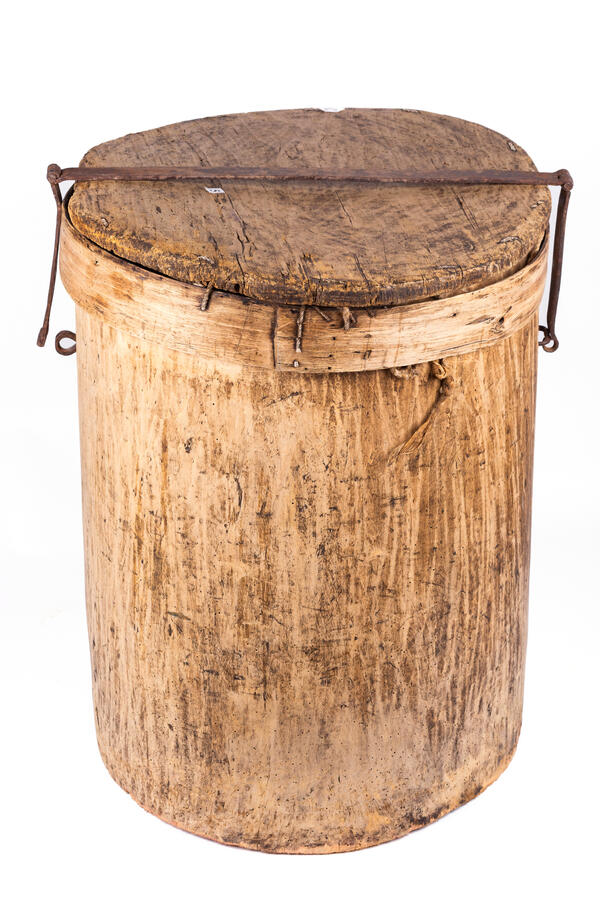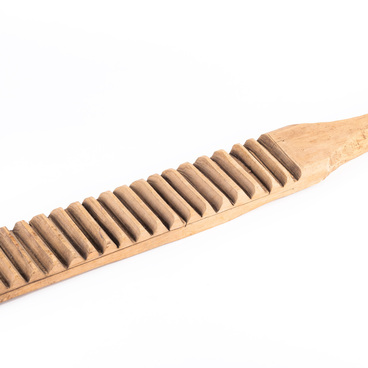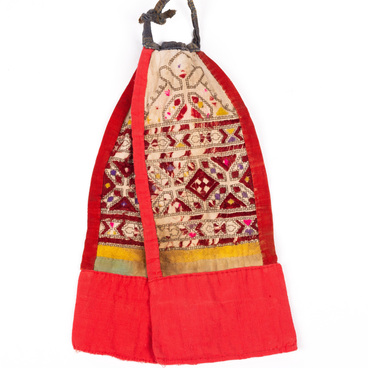Among the peoples that lived in forested areas, including the Chuvash, woodworking was one of the most well-developed crafts. That is why the Chuvash made almost all their home utensils out of wood. For tableware, both soft woods, including linden, willow, and aspen, and hard ones like oak and birch were used. Along with that, tableware could be made from either a single piece of wood or from rhizomes.
Larger vessels were made by hollowing out wood: for example, this is how the large troughs for flour dubbed ‘overnight stays’ were created. Hollowed out vessels were often used for storing and carrying food. One remarkable item like this is the supse made in the 20th century that is on display in the museum’s collection. The supse is a cylindrical container (tub) hollowed out of thick linden tree wood that was used to store clothes. The supse was closed on the top by a lid that sometimes had a lock that hung from it. A wooden box is a multifunctional and versatile item. Besides its direct purpose of storing things, it decorated the room and also introduced features of folk culture and ancient life into it.
Wooden utensils can be divided into several main groups, depending on the method used to produce them and the way in which they are used. First, there are hollowed out utensils that have a solid bottom. Second, there are hollowed out vessels that have a detachable bottom. The third group includes riveted items, and the fourth has vessels made from birch bark, bast, or bark. Finally, the last fifth group includes wicker utensils made from cane, bast, laths, or roots.
Hollowed out vessels are convenient for handling and storing grains, cereals, flour, and many other food products. Tableware was mostly chiseled from one piece of wood: bowls, salt shakers, ladles, and spoons. Chisel tools were used for crushing grains (millet, farro, barley, millet), hemp seeds, and salt, as well as processing raw materials (tow, cloth). For these purposes, mortars and pestles were used. Hollowed out vessels were imparted the required shape using a burning technique, and in these instances the finishing and cleaning were performed using a chisel.
The shape and size of the tableware, and the type of wood chosen for it, were dictated by its purpose. A large wooden bowl was suitable for putting out the first or second course — porridge or meat — to all family members. Young children were given food in bowls or cups Depending on the dishes that were served, shallow, deep, small, medium, or large bowls were used.
Larger vessels were made by hollowing out wood: for example, this is how the large troughs for flour dubbed ‘overnight stays’ were created. Hollowed out vessels were often used for storing and carrying food. One remarkable item like this is the supse made in the 20th century that is on display in the museum’s collection. The supse is a cylindrical container (tub) hollowed out of thick linden tree wood that was used to store clothes. The supse was closed on the top by a lid that sometimes had a lock that hung from it. A wooden box is a multifunctional and versatile item. Besides its direct purpose of storing things, it decorated the room and also introduced features of folk culture and ancient life into it.
Wooden utensils can be divided into several main groups, depending on the method used to produce them and the way in which they are used. First, there are hollowed out utensils that have a solid bottom. Second, there are hollowed out vessels that have a detachable bottom. The third group includes riveted items, and the fourth has vessels made from birch bark, bast, or bark. Finally, the last fifth group includes wicker utensils made from cane, bast, laths, or roots.
Hollowed out vessels are convenient for handling and storing grains, cereals, flour, and many other food products. Tableware was mostly chiseled from one piece of wood: bowls, salt shakers, ladles, and spoons. Chisel tools were used for crushing grains (millet, farro, barley, millet), hemp seeds, and salt, as well as processing raw materials (tow, cloth). For these purposes, mortars and pestles were used. Hollowed out vessels were imparted the required shape using a burning technique, and in these instances the finishing and cleaning were performed using a chisel.
The shape and size of the tableware, and the type of wood chosen for it, were dictated by its purpose. A large wooden bowl was suitable for putting out the first or second course — porridge or meat — to all family members. Young children were given food in bowls or cups Depending on the dishes that were served, shallow, deep, small, medium, or large bowls were used.



